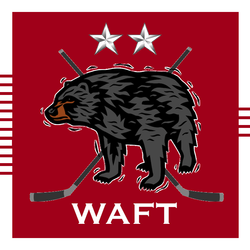Infrequently does either the men’s or women’s hockey program on East Hill hold anything over the other in terms of historic accomplishments and prestige; as one would expect of Cornellians. The Lady Rouge has won ten post-season tournaments in 45 years while its more testosterone-endowed counterpart has won 15 playoff championships in a century of intercollegiate competition. The women edge the men in championship winning rate by nearly 50% while the men uniquely can claim that three times their program has been declared the best in college hockey. As Cornell women so often do, they have a formidable, if not decisive, rebuttal that may be the last word in this tiff.
Making History
The expansion of women’s hockey beyond the ivy-covered walls of the Ancient Eight necessitated a more inclusive national tournament to decide an actual national champion. Northeastern University began competing in women’s hockey in 1978. The University of New Hampshire sponsored its first female icers in 1975. Meanwhile, the Ivy-League Tournament always excluded the third-oldest women’s hockey program. It hailed from Providence College.
Enter Providence.
The Friars began competing in 1973. Their success, including a 17-0 dismantling of Harvard, and the competitive elevation of the other two non-Ivy women’s program in the Northeast revealed that no program rightly could claim that it was national champion any longer without competing with these three other programs. The Eastern Association of Intercollegiate Athletics for Women provided the first instrument for determining which hockey program was the best in a given season. It hosted its first tournament at the end of the 1979-80 season.
The structure of the tournament was simple. It mirrored the format that the NCAA used in its Frozen-Four tournaments from 1948 through 1976. Only the four best, in the case of the EAIAW tournament, the four highest ranked, teams received invitations to vie for the spot atop the hierarchy of women’s hockey. The 1979-80 season decided which programs grappled in the first tournament sanctioned nominally to decide a national champion.
The four teams that ultimately received entry into the first EAIAW tournament were New Hampshire, Providence, Cornell, and Northeastern. The Wildcats of the Granite State accumulated 18 wins outside of the national tournament in the 1979-80 season. They did not lose. Northeastern received an invite on the tail of a 7-1 humbling of Harvard in the Beanpot. The Friars of Providence College rode the wave of a 19-2-0 regular-season record into the first national final four in women’s hockey. Cornell punched its ticket in predictable fashion. The Red outscored opponents 15 to four in a run to its fifth consecutive Ivy-League Championship to culminate a 16-5-0 season.
The inclusion of Cornell was a foregone conclusion. Cornell was the second-oldest women’s hockey program in the nation. It had dismantled the oldest program in the Ivy-League Championship Semifinal in nearly quintupling its opponent’s output. The Lady Rouge coined a fivepeat before vernacular for such an accomplishment was known.
Cornell drew Providence in the first national postseason. The teams had met earlier in the regular season. The Big Red did not hand the Friars one of their two losses. Cornell and Providence had met twice in their programs’s histories. The programs exchanged visits. Providence was victorious at Lynah Rink and Schneider Arena.
In a twist of fate drafted seemingly to test the mettle of the student-athletes of New York’s land-grant university, Schneider Arena was the studio of the 1980 EAIAW Championship. The carnelian and white returned to Schneider Arena to contest for a national title in March 1980. The task before this revolutionary program and its pioneering athletes was not unlike that which laid before the heroes who won Cornell’s first hockey championship in 1911 against Harvard in Boston Arena.
The players were fit and prepped. If there was a team that Cornell University would want to represent it in its first post-season, this was that team. The list of legends was fit for historical rolls. Sarah Mott tended the Red’s net. Brenda Condon and Cathy Northrop patrolled the blue line. Then, the list of Cornell’s forwards read like an all-star roster. It included Diane Dillon, Cheryl Hines, Cindy Warren, and Digit Degidio.
The game was hard-fought. Cornell, a program that had lost its two previous meetings to Providence by being outscored three to one, made the contest contentious from start to finish. Nevertheless, Digit, just minutes from her home, and her proud team fell victim to the emergent dominance of the Friars in a 5-3 decision. Cornell routed Northeastern, 5-1, the next day and Providence fell to New Hampshire, the only team to beat the Friars that season.
A third-place finish is not one celebrated at a program where cups overfloweth trophy cases. The invitation to compete with the sport’s best in the first national tournament is one that should be remembered. It ought to be immortalized as Cornell’s more recent national post-season runs are above the ice of one of hockey’s great sanctuaries.
That accomplishment makes women’s hockey at Cornell distinct. Bragging rights on this topic between the locker rooms on East Hill shift in favor of the ladies. It took the men’s program of Cornell University ten seasons to be invited to the Intercollegiate Hockey Association’s national tournament. The women’s program of the University was an inaugural invitee to the EAIAW’s national tournament.
The Lynah Faithful await banners that rightfully honor the Red’s 1911 IHA championship and invitation to the 1980 EAIAW Tournament. Both contribute to the excellence of Cornell hockey.
So, this weekend, when enjoying the contest at Lynah Rink, take a moment to realize and reflect that these programs truly did something remarkable together on one Spring day nearly four decades ago.



 RSS Feed
RSS Feed
